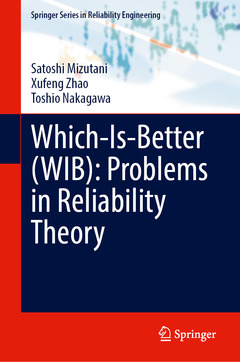Which-Is-Better (WIB): Problems in Reliability Theory, 1st ed. 2023 Springer Series in Reliability Engineering Series
Auteurs : Mizutani Satoshi, Zhao Xufeng, Nakagawa Toshio

This is the first book on the Which-Is-Better (WIB) Problem. These are questions that in daily life include such as ?Which is larger, younger and stronger?".
The main objective of this book is summarizing WIB Problems in maintenance and reliability theory. Optimal policies of replacement first, last and overtime are derived and compared theoretically and numerically, and WIB policies are determined. Furthermore, the reliability properties of parallel and standby systems are compared, and WIB system is determined. These WIB Problems are applied to shock and damage models and backup and checkpoint models of computer systems.
Dr. Satoshi Mizutani has interests of optimal maintenance policies in reliability theory such as inspection policy for computer systems and replacement policy for natural disaster. He has shown the several numerical examples of optimal replacement and checking times. His research for optimal maintenance and inspection policies has been published in Reliability Engineering & System Safety, International Journal of Reliability, Quality and Safety Engineering, Computers & Mathematics with Applications, and so on. Dr. Mizutani is a member of Nagoya Computer and Reliability Research organized by Professor Toshio Nakagawa in Japan.
Professor Xufeng Zhao is interested in probability theory, stochastic process, reliability and maintenance theory, and applications in computer and industrial systems. He has published two books in maintenance theory from Springer and more than seventy research papers in peer-reviewed journals, and he is the author or co-author of twelve chapters from Springer and Wiley, etc. He has obtained one best paper award from IEEE Reliability Society Japan Chapter and five best paper awards from international conferences in reliability, maintainability, and quality. Professor Zhao serves as an associate editor for Stochastic Models, that is an affiliated publication of INFORMS, and the editorial board and guest editors of other journals. He also severs as a program chair for ISSAT International Conference on Reliability and Quality in Design.
Professor Toshio Nakagawa has already published more than two hundred research papers on subject of maintenance and reliability theory in main reliability journals and has published five books titled on “Maintenance Theory in Reliability” in 2005, “Shock and Damage Models in Reliability Theory” in 2007, “Advanced Reliability Models and Maintenance Policies” in 2008, “Stochastic Processes with Applications to Reliability Theory” in 2011, “Random Maintenance Policies”
The first book on the "Which-Is-Better" (WIB) Problem Optimal policies in maintenance and reliability
Summarizes WIB Problems in maintenance and reliability theory
Demonstrates shock and damage models and backup and checkpoint models of computer systems
Date de parution : 05-2023
Ouvrage de 278 p.
15.5x23.5 cm
Disponible chez l'éditeur (délai d'approvisionnement : 15 jours).
Prix indicatif 168,79 €
Ajouter au panierThème de Which-Is-Better (WIB): Problems in Reliability Theory :
Mots-clés :
Reliability; Maintenance; New title; Replacement; Advanced problem



